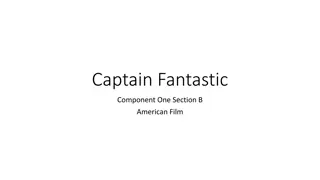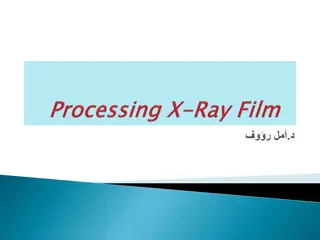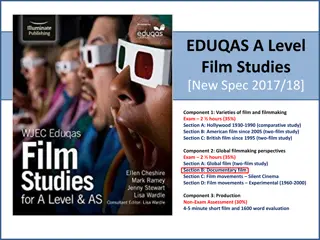Analyzing Spectatorship in American Independent Film Studies
Explore the concept of spectatorship in American independent films like "Captain Fantastic" (Ross, 2016). Understand the differences between passive and active spectatorship, and how sound and editing are used to evoke specific responses in the audience. Gain insights into how spectators interpret and engage with films, and consider the impact on their overall viewing experience.
Download Presentation

Please find below an Image/Link to download the presentation.
The content on the website is provided AS IS for your information and personal use only. It may not be sold, licensed, or shared on other websites without obtaining consent from the author. Download presentation by click this link. If you encounter any issues during the download, it is possible that the publisher has removed the file from their server.
E N D
Presentation Transcript
AMERICAN INDEPENDENT FILM EXAM PREP EDUQAS A Level Film Studies - Component 1: Varieties of Film and Film Making Section B: American Independent Film Case Study: Captain Fantastic (Ross 2016)
Component 1 exam You have 150 mins to answer 3 different questions in section A, B and C You should allow 50 mins per section.
The three areas to consider are: Film Form Meaning and Response Spectatorship
Spectatorship (revision) When we watch a film, there are different ways we can consume and interpret it. An audience member can watch from either an active or passive standpoint. This position is fluid, however, and is often heavily influenced by the way key elements of film form are constructed. Passive Spectatorship A passive spectator is someone who, when watching a film, reacts in the same way that a mass audience would. They accept the director's intended meaning and don t question the messages presented to them. They enjoy the immersive experience and don t seek to engage beyond a superficial level. Active Spectatorship On the other hand, some films (often independent films targeting more niche and highbrow audiences) encourage spectators to become more active producers of meaning by having to think about how to feel and respond to the film. When an active spectator watches a film, they watch it as an individual, and can take their own meaning from it. Active spectators generally analyse films and their meanings. ACTIVE AUDIENCE THEORY = STUART HALL RECEPTION ANALYSIS DOMINANT/PREFERRED, NEGOTIATE or OPPOSITIONAL READINGS
Examine how sound OR editing is used in used in one sequence from your chosen film? Discuss this question in small groups and write down some of the ideas you would include under each heading. Key scene Film Form (editing or sound) Meaning and response (Representation and aesthetics) Spectatorship (Encourages a passive or active response?)
Explore how spectators respond both passively and actively to film [40] You will have 20-25 mins to respond to this question in the exam. (allowing the other 20 mins to focus on your 2nd film example La La Land) Your response must address the subheadings from the exam paper: Task delete the prompts below and write your intro, plan your main body and decide on what you would include in a conclusion. What you understand by passive and active spectatorship responses. How aspects of film form invite both passive and active responses. To what extent spectators respond both actively or passively to the way filmmakers encourage them to respond. Intro Introduction to Captain Fantastic (Ross 2016) (demonstrate context). As an independent American film, it appeals to a certain niche audience. Films are received in different ways depending on the spectators reading and the filmmakers construction or choice of film form. Some films lend themselves to a passive/active reading. What do you understand by this? Main body Key scene 1: Choose a scene which is encouraging a passive reading. Remember to analyse with reference to all areas of Film Form and Meaning and Response. What do you believe the meaning of the scene is? (Passive is not the same as dominant/preferred reading as this is Stuart Halls active audience theory.) Film Form: Cinematography (Camera & Lighting) Mise en scene Editing Sound Key scene 2: A scene which is encouraging an active reading. Remember to analyse with reference to all areas of Film Form and Meaning and Response. You might like to consider a negotiated reading. Comment on who the audience is and how this will change the meaning they decode . What is the dominant reading of the scene and how could an audience receive or interpret a different meaning? Meaning and response: Representation (age/gender/class) Aesthetics (mood & look) Stuart Hall (1973) encoding and decoding & reception analysis (Preferred/negotiated/oppositional) Conclusion Link back to the question and demonstrate wider knowledge.























